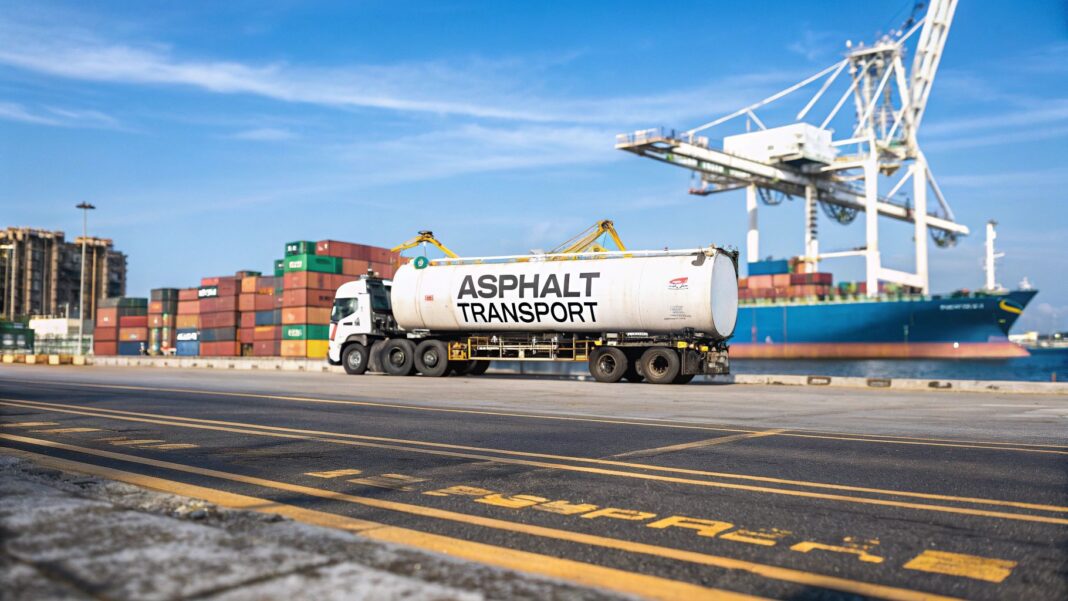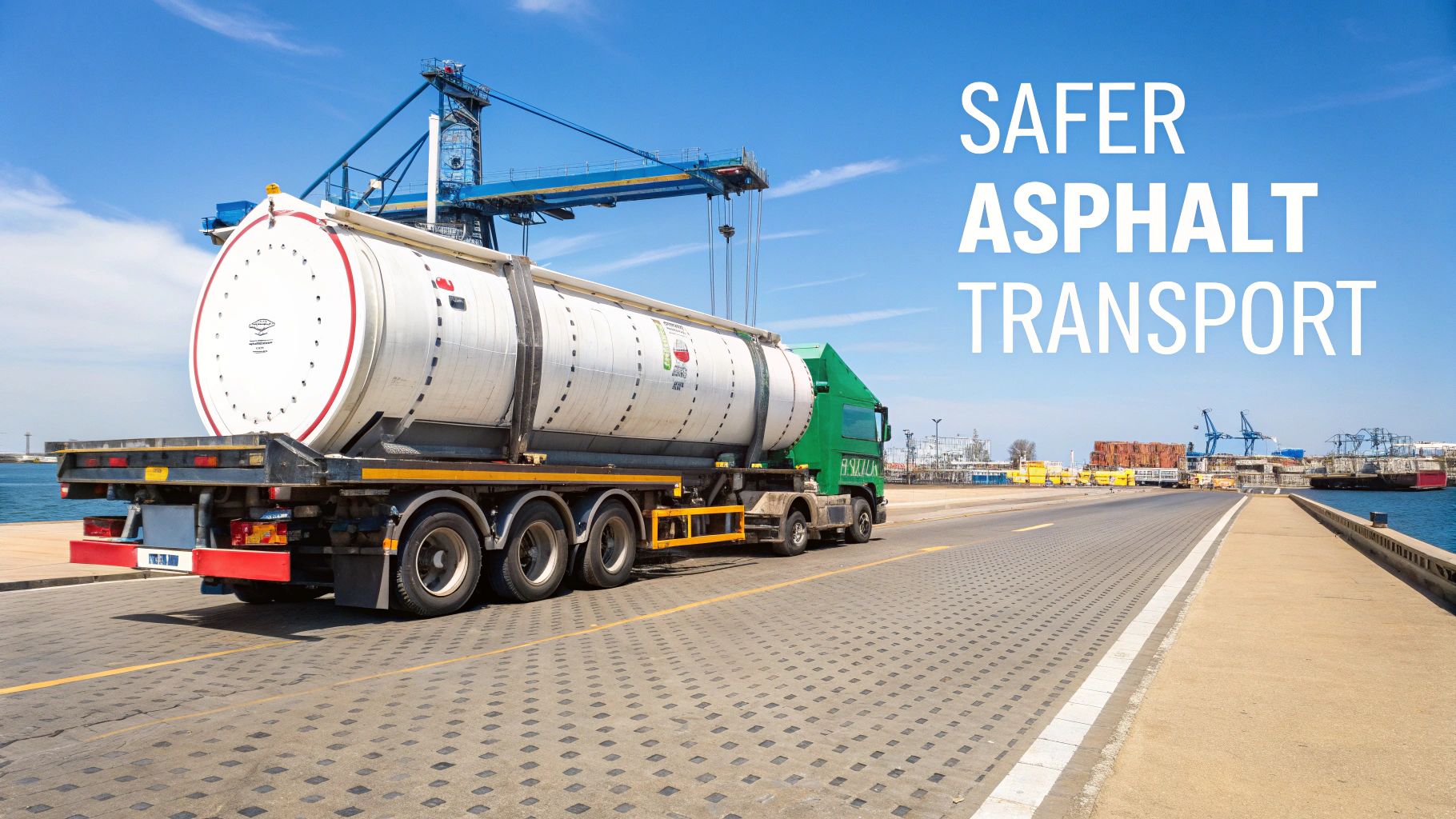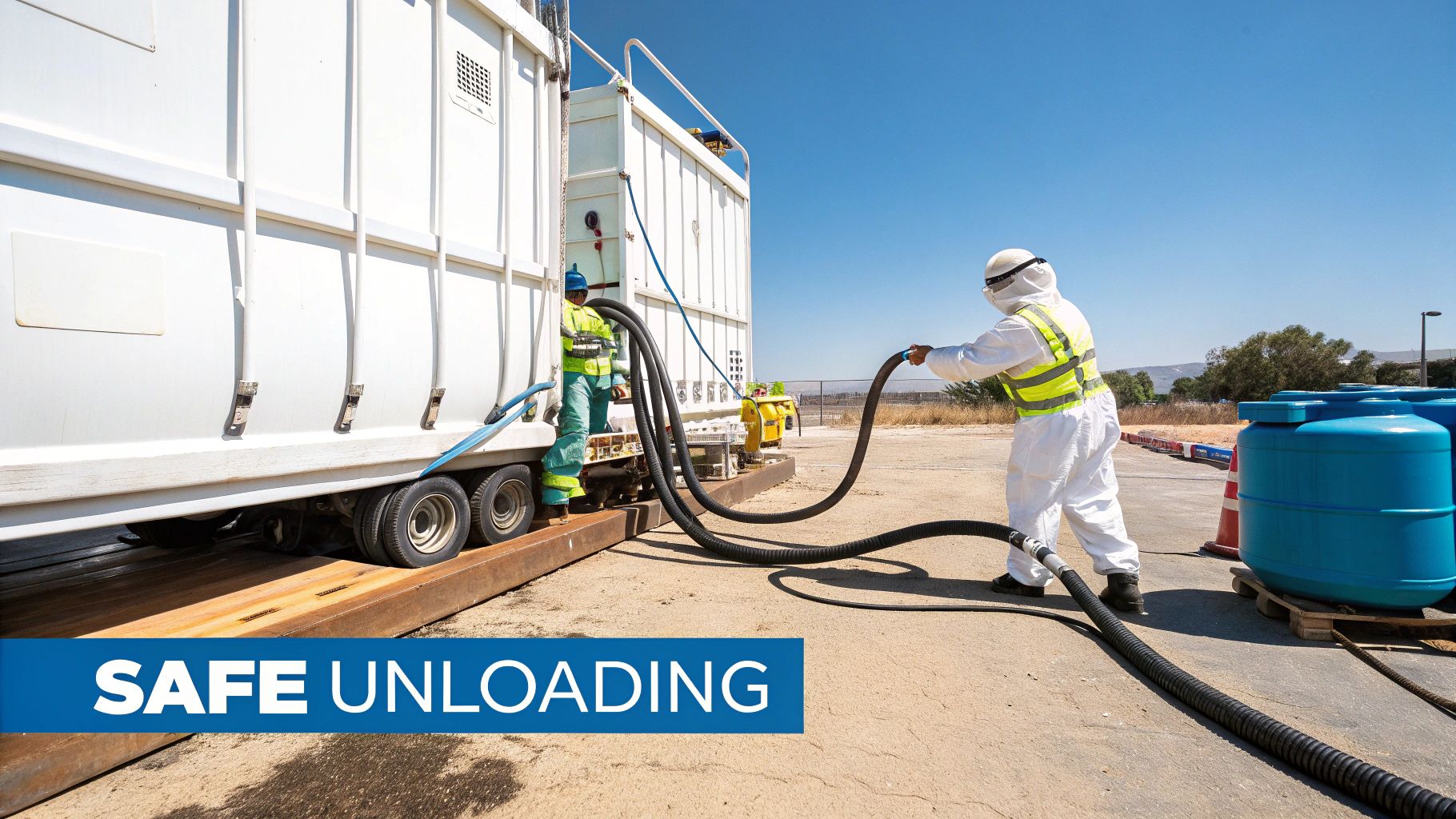
Transporting hot asphalt with traditional bulk tankers often presents logistical challenges—temperature loss, safety concerns, and unexpected delays can disrupt project timelines. Switching to specialized intermodal containers for asphalt transport offers a practical solution. This method seals in heat and quality from the refinery directly to your job site, providing actionable benefits like reduced waste and streamlined logistics.
Why Container Transport For Asphalt Is Gaining Traction

Delayed heated tankers can bring a project to a complete stop. Each transfer from a tanker to on-site storage introduces risks of spills, temperature drops, or safety incidents. By sealing asphalt in a dedicated container, you establish a closed-loop system that effectively retains heat and prevents contamination.
This containerized approach also significantly reduces handling points, eliminating the need for transfers between trucks and drums. The direct result is that asphalt arrives on-site at the correct temperature and viscosity, with its binding properties intact and ready for immediate use.
Key Operational Advantages
- Enhanced Safety: Minimizing transfers reduces personnel exposure to hot liquid asphalt, lowering the risk of burns and spills.
- Seamless Intermodal Moves: Containers can be transported by road, rail, or sea without requiring additional pumps or transfers between modes.
- Superior Quality Control: A sealed environment prevents oxidation and contamination, preserving the asphalt's performance characteristics.
- Environmental Compliance: The use of closed containers drastically reduces vapor emissions and the potential for environmental spills.
- Reduced Product Waste: Container transport minimizes "heel" residue, cutting material losses to as low as 2-3% per shipment.
“With container transport, project managers gain predictability—tight schedules, accurate inventory, and fewer financial surprises from degraded or wasted asphalt.”
Below is a quick comparison to highlight why many teams are making the switch.
Container Transport vs Traditional Bulk Methods
| Feature | Container Transport | Traditional Bulk Transport |
|---|---|---|
| Temperature Protection | Sealed, insulated containers maintain heat throughout transit | Multiple transfers cause temperature drops and inconsistent heating |
| Handling Frequency | Single handling from origin to destination | Several hand-offs, raising spill and safety risks |
| Intermodal Flexibility | Road, rail, sea—no need to pump out or reload | Often limited to one mode, requiring extra coordination |
| On-Site Storage | Container doubles as mobile storage tank, cutting equipment rental costs | Requires separate heated tanks or fixed infrastructure |
| Material Waste | Cuts product loss to 2-3% per shipment | Higher “heel” waste left in tankers |
This side-by-side comparison shows that container transport is a practical upgrade for asphalt logistics, leading to safer handling, better product quality, and more reliable schedules.
Choosing the Right Container for Your Asphalt Needs
Selecting the appropriate container is a critical decision that directly impacts the success of your asphalt delivery. The right choice ensures product quality is maintained from origin to destination, preventing costly material degradation.
Different containers are designed for specific applications, depending on the type of asphalt, transport distance, and budget. Making an informed choice from the outset is essential for preventing temperature loss and preserving the asphalt's integrity.
- Bitutainers are the industry standard for long-distance sea transport. These are specialized tank containers equipped with integrated heating systems and robust insulation to maintain liquid asphalt at optimal temperatures.
- Flexitanks offer a cost-effective alternative for medium-range land transport. They are essentially large, durable liquid liners fitted inside a standard shipping container.
- Block Containers are used for transporting solid asphalt. Since no heating is required, a standard dry freight container is sufficient for moving solid blocks safely.
Each option presents a different balance of capacity, temperature control, and cost. For example, a municipal paving team transporting solid asphalt blocks to a neighboring state can use standard block containers, avoiding the expense of specialized heating systems.
Evaluate Temperature Needs and Container Specs
Liquid asphalt must be maintained between 150°C and 180°C to preserve its viscosity for application. If the temperature drops too low, the product becomes unworkable, leading to significant financial loss.
Insulated tanks are invaluable for this reason. They retain heat far more effectively, reducing the fuel and time required for reheating at the destination. While a heated bitutainer may have a higher daily rental cost (approximately 15-20% more), the savings from reduced remelting time often justify the investment.
Flexitanks, lacking active heating, are best suited for shorter routes or for deliveries to facilities equipped for preheating. With block containers, temperature is not a concern during transit, but proper palletizing and securing are crucial to prevent shifting.
“Choosing a container that aligns with asphalt form and route length minimizes waste and keeps projects on schedule.”
A common oversight is failing to account for headspace in flexitanks, which can cause dangerous pressure buildup. Always verify that the container's pressure relief valves are functional—this is a non-negotiable safety check.
The market for this equipment is expanding, with recent analysis indicating sustained growth in asphalt storage tanks through 2031, driven by new infrastructure projects. Learn more about asphalt storage tank market growth.
Compare Costs and Operational Factors
Evaluating cost requires looking beyond the initial rental price. A flexitank may seem cheaper, but it might necessitate more on-site personnel and equipment for thermal management. A holistic cost analysis is essential.
Scrutinize rental agreements for hidden fees. Some contracts are all-inclusive, covering maintenance, heating fuel, and repairs, while others may bill these items separately.
| Container Type | Thermal Control | Typical Capacity | Relative Cost |
|---|---|---|---|
| Bitutainer | Active heating & insulation | 20,000–25,000 L | High |
| Flexitank | Passive insulation only | 24,000–26,000 L | Medium |
| Block Container | None (solid form) | 18–20 MT | Low |
Your logistics plan should account for variable costs like heating fuel surcharges, which can impact the total transport budget. For instance, a port operator who switched from flexitanks to bitutainers saw their product rejection rates drop by 40%, saving weeks on project timelines and demonstrating how the right equipment choice can deliver significant returns.
If you're managing similar logistics for other heavy equipment, our guide on container relocation can be a big help. Read about moving containers with We Will Transport It.
Draft Your Container Selection Checklist
Before finalizing any contracts, use this checklist to ensure all critical factors are addressed:
- What is the asphalt's form (liquid/solid) and required minimum temperature?
- Is the container's insulation sufficient for the transit duration and climate?
- Is the heating system adequate, and is fuel readily available at all points?
- What is the total cost, including rental, purchase, and all ancillary fees?
- Have safety features like pressure relief valves and insulation integrity been inspected?
- What are the established procedures for loading, unloading, and emergency response?
Thoroughly reviewing these questions will help you make a sound decision. For example, preloading solid asphalt blocks into standard containers can reduce transport costs by up to 30% compared to using insulated tanks for liquid asphalt, offering a significant saving where applicable. Following this structured approach ensures your asphalt arrives at the correct temperature, on budget, and on schedule.
Preparing and Loading Asphalt for Safe Transit
Proper preparation is the foundation of a successful container transport operation for asphalt. The process begins well before loading, with precise temperature management of the product itself.
The goal is to heat the asphalt to its optimal loading temperature, typically between 150°C and 180°C. Overheating can degrade the binder and compromise its performance, while underheating makes the asphalt too viscous for efficient loading. Many facilities use specialized IBC tote heating solutions, such as base heater pads, to apply consistent, controlled heat without creating damaging hot spots.
This process flow chart breaks down the key decisions involved in selecting a container for your asphalt.
As shown, the decision between a specialized bitutainer and a standard block container depends directly on the asphalt's form (liquid or solid) and the required level of thermal control.
Filling and Sealing Containers Correctly
The loading process itself requires precision. A critical and common error is overfilling the container. It is essential to manage ullage—the headspace left at the top—to allow for thermal expansion of the asphalt during transit.
Insufficient ullage can lead to dangerous pressure buildup, potentially rupturing the container and causing hazardous leaks. The industry standard is to fill containers to 90-95% of their capacity, but always consult the manufacturer's specifications for your specific product and anticipated temperature fluctuations. This step is crucial for protecting both the cargo and the container. For those new to this process, engaging specialized tank shipping services can provide valuable insight into these safety protocols.
After filling, a comprehensive pre-trip inspection is mandatory. Every valve, hatch, and fitting must be inspected to ensure a perfect seal. Even a minor leak can result in significant product loss, environmental contamination, and costly cleanup operations.
A detailed pre-loading checklist is your best defense against in-transit failures. It forces a systematic review of all potential weak points before the container ever leaves the facility.
Pre-Trip Inspection Checklist
Before dispatching an asphalt shipment, complete this final inspection to prevent common loading-related issues.
- Valves and Fittings: Confirm all discharge and inlet valves are fully closed and secured. Inspect gaskets and seals for any signs of wear or damage.
- Hatches and Manlids: Ensure the main loading hatch is sealed tightly and all clamping and locking mechanisms are properly engaged.
- Container Exterior: Conduct a thorough walk-around inspection, looking for visible damage, leaks, or stress fractures, particularly around welded seams.
- Documentation: Verify that correct hazardous materials placarding (if required) is clearly displayed on all four sides of the container.
This meticulous approach ensures that once loaded, your asphalt remains securely contained until it reaches its destination.
Navigating Global Demand and Logistics Challenges
The global asphalt market is dynamic, and these shifts directly influence your transport logistics. Successfully shipping asphalt in containers requires an understanding of the economic landscape to anticipate challenges, avoid costly delays, and manage freight costs effectively.
For instance, a sudden infrastructure boom in a specific region can tighten shipping capacity and drive up prices. Conversely, a market slowdown can free up vessels, creating opportunities for more favorable rates. Proactively monitoring these trends is key to building a resilient supply chain.
Understanding Market Dynamics and Their Impact
Asphalt demand is closely tied to global construction and infrastructure spending, which is currently in a growth phase. Global revenues are projected to increase from approximately $56.2 billion in 2021 to $66.1 billion by 2025. This growth intensifies competition for transport services. You can find more details in this in-depth asphalt market analysis.
This demand is not uniform globally. The Asia-Pacific region accounts for nearly 40% of the global market share, with countries like China, India, and Japan undertaking massive road and urban development projects. When shipping to or from these high-demand areas, be prepared for:
- Congested Shipping Lanes: Major sea routes can experience significant traffic, adding days or weeks to transit times.
- Higher Freight Rates: Increased competition for container slots typically leads to higher shipping costs.
- Port Delays: Busy ports often have longer wait times for loading and unloading, disrupting project schedules.
By keeping a close eye on regional construction trends, you can get ahead of the game. Try booking your capacity during off-peak times or even looking at alternative, less crowded shipping routes to keep your schedule and budget from blowing up.
Understanding these regional nuances is essential, as each market presents unique logistical challenges and opportunities. The following table outlines key factors influencing asphalt transport in different global markets.
Regional Asphalt Demand and Logistical Factors
| Region | Demand Driver | Logistical Consideration |
|---|---|---|
| Asia-Pacific | Massive infrastructure and urbanization projects (China, India). | Port congestion, competition for vessel space, and volatile freight rates. |
| North America | Road maintenance, repair, and new housing construction (USA, Canada). | Inland transport capacity, seasonal demand peaks, and rail network reliability. |
| Europe | Strict environmental regulations and sustainable infrastructure initiatives. | Compliance with REACH regulations, focus on eco-friendly transport options. |
| Middle East | Large-scale new city and transportation network development. | Extreme temperatures requiring specialized containers, geopolitical stability risks. |
| Latin America | Economic development driving new road and airport construction. | Varying port infrastructure quality, potential for customs delays. |
This data underscores why a one-size-fits-all logistics strategy is ineffective. A successful approach requires tailoring your plan to the specific market you're serving.
Building a Resilient Supply Chain Strategy
A reactive approach to logistics is a recipe for failure. A resilient strategy must be flexible and forward-thinking, focused on building strong partnerships and having contingency plans.
For example, when shipping into a major hub like the Port of Los Angeles, a labor strike or equipment shortage can cause significant disruption. Having a backup plan, such as the ability to divert to a nearby port or access to alternative trucking services, is invaluable. Understanding the operational specifics of major ports is a critical first step. You can learn more about freight shipping through the Port of Los Angeles to better prepare for its unique challenges.
Here are actionable tips for strengthening your logistics network:
- Diversify Your Carriers: Avoid relying on a single shipping line. Working with multiple carriers provides flexibility and leverage if one encounters issues.
- Forward Contracting: For long-term projects, consider locking in freight rates with forward contracts to protect your budget from market volatility.
- Improve Demand Forecasting: Collaborate closely with project managers to develop accurate timelines. Better demand prediction enables more efficient planning for your container transport asphalt needs.
Ultimately, success in the global market depends on a combination of data-driven analysis and practical planning. By making logistics a core component of your strategy, you can transform potential challenges into a competitive advantage.
Keeping Your Shipment on Track: Managing In-Transit Variables and Regulations
Once your asphalt shipment is in transit, the focus shifts from preparation to active, real-time management. This phase involves navigating complex regulations and unpredictable variables to ensure your cargo arrives on time, at the correct temperature, and without compliance penalties.
Regional market conditions can be a major variable. Asphalt demand fluctuates based on local economies, construction cycles, and even weather patterns, all of which affect shipping availability and cost for container transport asphalt services.
For instance, recent soft demand in Southeast Asia has led to lower bitumen prices in the trading hub of Singapore, creating a backlog of unsold product and idle vessels. This situation in neighboring countries like Indonesia, Vietnam, and Thailand, caused by delayed road projects, highlights how sensitive logistics planning must be to on-the-ground realities.
Dotting the I's and Crossing the T's: Compliance and Documentation
There is no margin for error in the documentation for shipping asphalt. A single missing or incorrect document can lead to your container being held in customs for days or weeks, causing delays that could result in the asphalt cooling beyond a usable state.
Ensure every shipment includes accurate and complete documentation, especially:
- Safety Data Sheets (SDS): This document provides essential information on the asphalt's properties and potential hazards for handlers, emergency responders, and port authorities. It is mandatory for transit.
- Customs Declarations: Be meticulous. Any discrepancy between the declaration and the actual contents can trigger inspections, fines, and significant delays.
Think of your documentation as your cargo’s passport. If it’s not perfect, your shipment isn't going anywhere. A simple typo can create a domino effect that messes up your entire project schedule.
Using Tech to Keep an Eye on Things
Modern technology allows you to monitor your shipment's status in real time. Remote monitoring systems equipped with GPS and temperature sensors are invaluable tools, providing live data on the container's location and, most importantly, the internal temperature of the asphalt.
Advanced construction material tracking software is particularly effective. These systems can send instant alerts if the temperature deviates from the acceptable range, giving you the opportunity to intervene before the product is compromised. This transforms the process from a reactive, uncertain wait into a proactive, controlled operation, protecting your investment throughout its journey.
Getting the Asphalt Out: A Safe and Efficient Unloading Process

The final step, unloading the asphalt, requires precision and adherence to strict safety protocols. A well-executed transfer preserves product quality and prevents costly incidents. A systematic plan, from reheating to final discharge, is essential.
First, the asphalt will likely require reheating. Even with excellent insulation, some temperature loss during transit is inevitable. Many modern containers feature built-in heating systems, such as direct-fire tubes or thermal oil coils, which simplify this process. If using external heating, apply it slowly and evenly to avoid scorching, which can alter the asphalt's properties. The target temperature for a workable viscosity is typically between 150°C and 160°C.
The Pre-Unloading Safety and Connection Checklist
A pre-transfer safety check is non-negotiable. Before connecting any hoses, ensure the container is positioned on solid, level ground. An unstable or tilted container can create uneven pressure and make it difficult to operate the valves safely.
Your team should conduct a full site and equipment inspection using this checklist:
- Stable Ground: Is the surface solid enough to handle the full weight of the container without any shifting or sinking?
- Hose Check: Look over every inch of the transfer hoses. You're searching for cracks, weird bulges, or any other signs of wear and tear. Make sure the couplings are clean and the gaskets look good.
- Valve Function: Confirm all valves on both the container and the receiving tank are closed and working properly before you connect anything.
- Pressure Relief: Give the pressure relief valves on the container and hoses a once-over to ensure they're clear and ready to do their job.
From my experience, the vast majority of unloading accidents happen because someone skipped these basic safety checks. Taking five minutes to inspect your hoses, valves, and personal protective equipment (PPE) can be the difference between a smooth transfer and a dangerous spill.
Managing the Discharge
Once all connections are secure and safety checks are complete, you can begin the transfer. The key is to proceed slowly and maintain control. Start by opening the valves slightly to allow pressure to equalize across the system before opening them fully. A sudden pressure surge can cause hose whip or coupling failure.
During the entire process, one person should be designated as a monitor. Their sole responsibility is to watch the pressure gauges and listen for any unusual equipment noises, ready to initiate an emergency shutdown if necessary.
Always have spill containment kits readily accessible at the transfer point. Having absorbent materials and booms on hand can mitigate a potential spill, turning a potential disaster into a minor cleanup. Adhering to these protocols ensures a safe and efficient transfer every time.
Got Questions About Shipping Asphalt in Containers? We've Got Answers.
Even experienced project managers may have questions when adopting container transport for asphalt. This is a specialized process, and understanding the details is key. Here are answers to some of the most common inquiries.
How Do You Keep Asphalt Hot on a Long Sea Voyage?
This is a critical concern. Maintaining a precise temperature for a product during a multi-week sea voyage is essential to prevent it from solidifying.
The solution lies in specialized equipment. High-quality bitutainers are engineered specifically for this purpose. They feature robust insulation and integrated heating systems capable of maintaining asphalt at a consistent 160°C. These systems can be powered by the vessel or a dedicated power pack, ensuring the asphalt arrives at its destination hot and ready for immediate use, which saves significant time and reheating costs.
Isn't This More Expensive Than Bulk Shipping?
While the upfront rental cost of a specialized bitutainer may seem higher, it's important to consider the total cost of ownership.
Traditional bulk transport often involves hidden costs that are eliminated with containerization. With containers, you experience minimal product loss from transfers, you don't need large on-site storage tanks, and your reheating fuel costs are drastically reduced.
When you factor in the efficiency and the massive reduction in risk, containerized transport often comes out ahead. You’re not just buying transport; you’re protecting your project's timeline and budget from some very expensive problems.
What Happens if a Shipment Gets Delayed?
Logistics are inherently unpredictable due to factors like weather, port strikes, or customs issues. So, what is the contingency plan if your asphalt shipment is delayed?
A reliable logistics partner will have a proactive strategy. This includes having alternative shipping routes mapped out and identifying available heating sources at destination ports. Real-time tracking is crucial, as it provides early warnings of potential delays, allowing for timely adjustments to the schedule and preventing a logistical issue from becoming a critical problem.
My Container Doors are Jammed. Now What?
This is a practical, on-site problem that can occur, especially on unpaved or uneven job sites. A slight twist in the container frame due to unleveled ground can cause the doors to jam.
Fortunately, the solution is usually straightforward. A simple bottle jack can be used to level the container. By placing the jack under the corner casting and carefully raising it, you can relieve the pressure on the frame, allowing the doors to open freely. This practical tip can save significant time and frustration on-site.
At We Will Transport It, we handle the complexities of specialized shipping so you can focus on your project. Our team of logistics experts ensures your heavy equipment and materials arrive safely and on schedule, every time. Get a transparent, no-hassle quote for your next shipment by visiting us at https://www.wewilltransportit.com.





